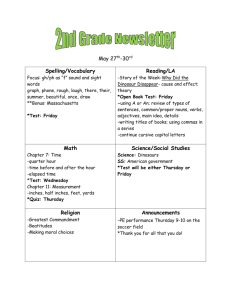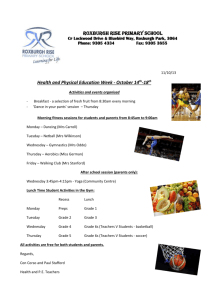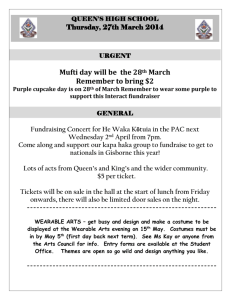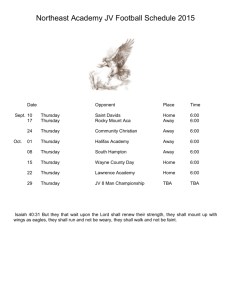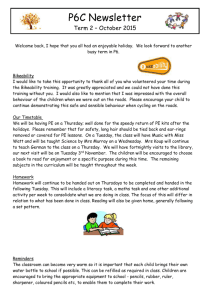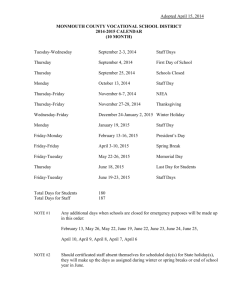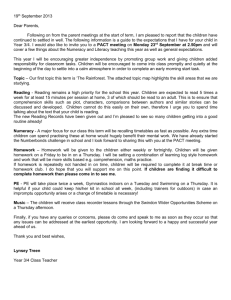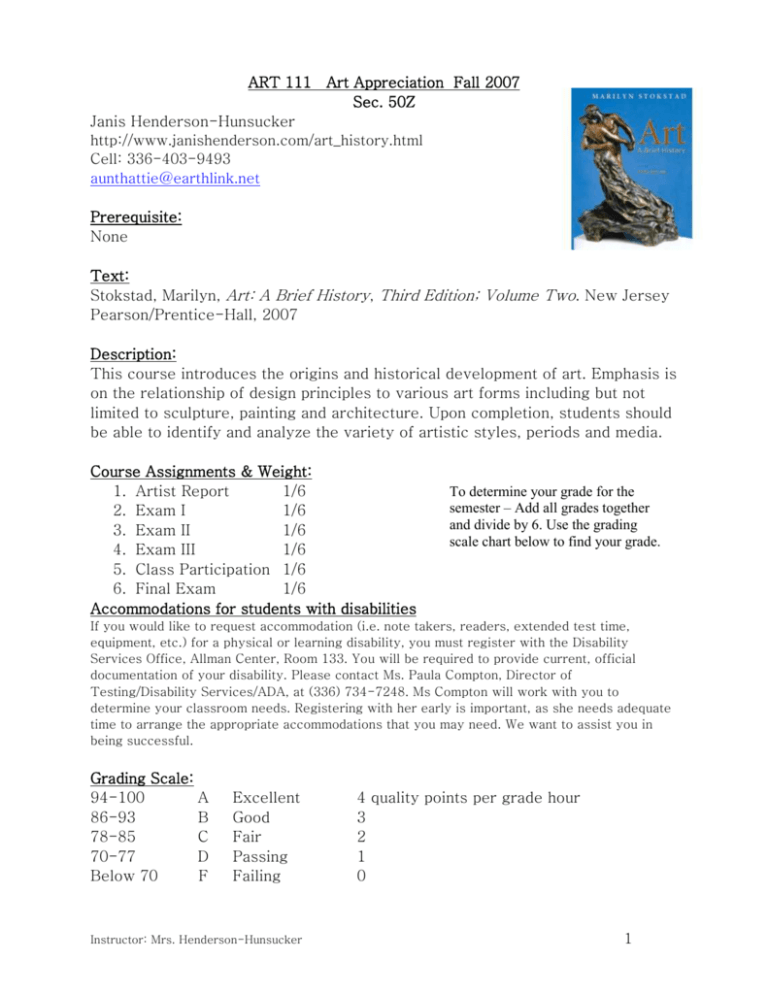
ART 111 Art Appreciation Fall 2007
Sec. 50Z
Janis Henderson-Hunsucker
http://www.janishenderson.com/art_history.html
Cell: 336-403-9493
aunthattie@earthlink.net
Prerequisite:
None
Text:
Stokstad, Marilyn, Art: A Brief History, Third Edition; Volume Two. New Jersey
Pearson/Prentice-Hall, 2007
Description:
This course introduces the origins and historical development of art. Emphasis is
on the relationship of design principles to various art forms including but not
limited to sculpture, painting and architecture. Upon completion, students should
be able to identify and analyze the variety of artistic styles, periods and media.
Course Assignments & Weight:
1. Artist Report
1/6
2. Exam I
1/6
3. Exam II
1/6
4. Exam III
1/6
5. Class Participation 1/6
6. Final Exam
1/6
Accommodations for students with disabilities
To determine your grade for the
semester – Add all grades together
and divide by 6. Use the grading
scale chart below to find your grade.
If you would like to request accommodation (i.e. note takers, readers, extended test time,
equipment, etc.) for a physical or learning disability, you must register with the Disability
Services Office, Allman Center, Room 133. You will be required to provide current, official
documentation of your disability. Please contact Ms. Paula Compton, Director of
Testing/Disability Services/ADA, at (336) 734-7248. Ms Compton will work with you to
determine your classroom needs. Registering with her early is important, as she needs adequate
time to arrange the appropriate accommodations that you may need. We want to assist you in
being successful.
Grading Scale:
94-100
A
86-93
B
78-85
C
70-77
D
Below 70
F
Excellent
Good
Fair
Passing
Failing
Instructor: Mrs. Henderson-Hunsucker
4 quality points per grade hour
3
2
1
0
1
Withdrawal Policy:
W – A withdrawal is the grade given to students who officially withdraw from a
course through the 8th week of fall and spring semesters. A drop Form may be
obtained in the Records Office (Allman 106). When students fail to notify the
Records Office, they may receive a failing grade.
Attendance:
Students must stisfy the instructor that they should be permitted to remain in a
course and attend classes after incurring absences in excess of the following:
five hours of class.
The Rules:
1. There is no difference between an excused and an unexcused absence. Once
a student has reached five hours of absences, the student must contact the
instructor to remain in the class. Otherwise, the student will be withdrawn
from the class.
2. The class will begin on time. Students are expected to remain for the entire
class. Arriving late or leaving early will be counted as an absence. Please do
not leave during the class unless you have spoken with the instructor prior to
class. Three hour classes will be give a break approximately 1 hour and 15
minutes into the class. Students must return from break on time to be counted
present for the class. Sleeping=absent!
3. Turn off all cell phones. Never let a phone ring in class and NEVER answer
the phone in class. If there is an emergency, please notify the instructor
before class that you may need to step outside to receive a call.
4. EXAM/TEST POLICY: Students MUST take exams/tests during the scheduled
class period, unless they receive permission prior to the test day. Students
who do not receive permission will receive a ZERO on that test/exam.
PLEASE NOTE: You may take an Exam early if there is a schedule conflict.
5. LATE PAPERS/ASSIGNMENTS: Papers not received at the beginning of class
on the assigned due date will receive an automatic 10 point penalty. Students
with “printer problems” must find an alternative solution, so do not wait until
the morning the paper is due to print it out. Late papers will only be accepted
for 3 days following the due date. Please note: Same day (not at the beginning
of class) –10 pts. Next day: -20 pts. 2 days late: -30 pts. 3 days late: -40pts.
Cell Phone Policy:
Forsyth Tech considers the use of cell phones to be disruptive to the classroom setting.
Therefore, students are to turn off all cell phones and other electronic devices while attending
class or participating in class-related activities (i.e., labs, clinical, etc.) Students who do not
comply will be considered in violation of the Student Code of Conduct, and appropriate
disciplinary action will be taken.
Instructor: Mrs. Henderson-Hunsucker
2
ART 111 Art Appreciation Fall 2007
TENTATIVE CLASS SCHEDULE
Thursday, August 23
Course Introduction – Why Study Art?
August 29 – Last Day for 75 % refund for full term
Thursday, August 30
The Formal Elements of Art – Prehistoric Art
Thursday, September 6
Read Chapters 2 & 3
Mesopotamia & Egypt – Early Asian Art
Thursday, September 13
Read Chapters 4 & 5
Greek Art
Thursday, September 20
Read Chapters 6 & 7
Roman Art – Jewish, Early Christian & Byzantine
Thursday, September 27
Read Chapters 8 & 9
TEST I - Islamic & Later Asian Art
Thursday, October 4
Read Chapters 10
Early Medieval & Romanesque Art
Thursday, October 11
Gothic & Early Renaissance Art
October 17th - Last Day to Drop without penalty for full semester
Read Chapters 11 &12
Thursday, October 18
Test II - Renaissance Art
October 22-26 Advising Week for Continuing Students
Read Chapter 13
Thursday, October 25
Read Chapter 14
Baroque & Rococo Art
Thursday, November 1
Read Chapters 15 &16
Art of the Americas & African Art
Thursday, November 8
Read Chapter 17
Thursday, November 15
Read Chapter 18
Test III - Neoclassicism, Romanticism & Realism
Later 19th C. Art
Thursday, November 22 No Class -- Holiday
November 26-27 Walk-In Registration for New and Continuing Students 8am – 7pm
Thursday, November 29
Read Chapter 19
Artist Profile Due - Modern Art
Thursday, December 6
Read Chapter20
Thursday, December 13 Last Class
Art Since 1945
Instructor: Mrs. Henderson-Hunsucker
Final Exam
3
ART 111 Art Appreciation Fall 2007
ARTIST REPORT GUIDELINES
Fill out the Artist Report graphic organizer to help you create your paper. The
graphic organizer will need to be stapled to the back of your paper when turned in.
Your “selected bibliography” must include at least four in depth sources. Magazine
articles and internet sources can be excellent but do not replace books. You must
have at least one book listed in your bibliography. You can use your textbook as a
reference source. Develop an original, thoughtful thesis, a reason why this artist is
important to society and art history.
Research papers will be evaluated competitively on the following three criteria:
1. Research: Show that you have learned, discovered, read, and absorbed
information that is appropriate to the class.
2. Critical thought: Make a compelling argument supported by your own
observations and assessments.
3. Literary expression: Present, organize and communicate your arguments for
maximum impact and support of your thesis and document using MLA
formatting and style (http://owl.english.purdue.edu/owl/resource/557/01/)
Additional Guidelines For Research Papers:
Use one inch margins on all four sides, double spacing, and twelve point letter
height. Write in the third person as much as possible (no I, me, or you). You can
use your voice in the personal reflection section. Refer to the artist by their last
name, no title is necessary. Your paper must include a “selected bibliography” page
showing all of your related reading. It must have a thesis. You may include
descriptive writing, formal analysis, the artist's choice of medium, discussion of the
artwork, meaning and purpose of the work, and whether it has political, religious, or
psychological significance. You may consider how the work fits into the artist's
oeuvre or the flow of art history, its influence, and what influenced it. These are
ideas to get you going. You do not need to cover them all. Rather, focus on your
own thesis.
The following are some rules to keep in mind as you write your essays.
1. Include concrete, specific examples to support what you say.
2. Make your writing objective rather than subjective. For example, instead
of writing "She has a good use of perspective,” write "She uses linear
perspective to give the illusion of depth.”
3. Titles of works of art should be italicized (use your text as a guide).
4. Art movements (Impressionism, for example) should be capitalized.
5. Don't rely too heavily on your sources, e.g., more than two or three
footnotes per page might indicate too much reliance on outside sources.
You should conclude paragraphs with your own idea rather than a
quotation. If you plagiarize someone else’s work it constitutes academic
dishonesty.
Instructor: Mrs. Henderson-Hunsucker
4
6. Use the MLA style for footnotes. You do not need to footnote common
knowledge, even if you found it in the text. You must footnote direct
quotations as well as logic or arguments that originated with someone
else.
7. Revise and proofread. Writing another draft will make it better.
If you would like to propose a variation or alternate research project instead of the
artist paper please submit what you propose to do in writing for approval first.
Instructor: Mrs. Henderson-Hunsucker
5
USING MLA STYLE TO DOCUMENT AND CITE SOURCES
Personal site
Pellegrino, Joseph. Home page. 16 Dec. 1998. 1 Oct. 1999
< http://www.english.eku.edu /pellegrino/personal.htm>.
Professional site
The William Faulkner Society Home Page. Ed. Mortimer, Gail. 16 Sept. 1999.
William Faulkner Soc. 1 Oct. 1999 <http://www.acad.swarthmore.edu/faulkner>.
NAIC Online. 29 Sept. 1999. National Association of Inventors Corporation. 1
Oct. 1999 <http://www.better-investing.org/>.
U. S. Department of Education (ED) Home Page. 29 Sept. 1999. US Dept. of
Education. 1 Oct. 1999 <http://www.ed.gov/index.html>.
William Faulkner on the Web 7 July 1999. U of Mississippi. 20 Sept. 1999
<http://www.mcsr.olemiss.edu/~egjbp/faulkner/ faulkner.html>.
Book
An online book may be the electronic text of part or all of a printed book, or a booklength document available only on the Internet (e.g., a work of hyperfiction).
Bird, Isabella L. A Lady's Life in the Rocky Mountains. New York, 1881.
Victorian Women Writers Project. Ed. Perry Willett. 27 May 1999. Indiana U. 4
Oct. 1999 < http://www.indiana.edu/~letrs/vwwp/ bird/rocky.html>.
Article in an electronic journal (ejournal)
Joyce, Michael. "On the Birthday of the Stranger (in Memory of John Hawkes)."
Evergreen Review 5 Mar. 1999. 12 May 1999
<http://www.evergreenreview.com/102/evexcite/joyce/nojoyce.html>.
Wysocki, Anne Frances. "Monitoring Order: Visual Desire, the Organization of
Web Pages, and Teach the Rules of Design." Kairos: A Journal for Teachers of
Writing in Webbed Environments 3.2 (1998). 21 Oct. 1999
<http://english.ttu.edu/kairos/3.2/features/wysocki/mOrder0.html>.
Article in an electronic magazine (ezine)
Adler, Jerry. "Ghost of Everest." Newsweek 17 May 1999. 19 May 1999
<http://newsweek.com/nw-srv/issue/20_99a/printed/int/socu/ so0120_1.htm>.
Newspaper article
Wren, Christopher. "A Body on Mt. Everest, a Mystery Half-Solved." New York
Times on the Web 5 May 1999. 13 May 1999
<http://search.nytimes.com/search/daily/bin/fastweb?getdoc+site+
site+87604+0+wAAA+%22a%7Ebody%7Eon%7Emt.%7Eeverest%22>.
Review
1. Michael Parfit, review of The Climb: Tragic Ambitions on Everest, by
Anatoli Boukreev and G. Weston DeWalt, New York Times on the Web 7 Dec.
1997, 4 Oct. 1999 <http://search. nytimes.com/
books/97/12/07/reviews/971207.07parfitt.html>.
Instructor: Mrs. Henderson-Hunsucker
6
Editorial
"Public Should Try Revised Student Achievement Test." Editorial. Lexington
Herald-Leader 13 Apr. 1999. 4 Oct. 1999
<http://www.kentuckyconnect.com/heraldleader/news/041399/
editorialdocs/413test-1.htm>.
FROM: http://www.bedfordstmartins.com/online/cite5.html#1
Instructor: Mrs. Henderson-Hunsucker
7

